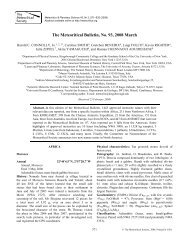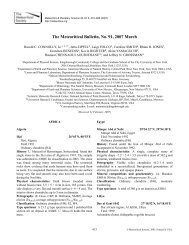You also want an ePaper? Increase the reach of your titles
YUMPU automatically turns print PDFs into web optimized ePapers that Google loves.
588<br />
FA suite chronology (Norman et al., 2002b). But a<br />
more impressive argument, which I would now<br />
rank ahead of that one, is based on the geochemical<br />
bimodality of the pristine nonmare rocks<br />
(Figure 13). <strong>The</strong> singularly low-mg composition<br />
of the FA suite must reflect a special process of<br />
origin. Warren (1986) argued that a deep, originally<br />
ultramafic magma ocean is the only plausible<br />
scenario for engendering a global component of<br />
low-mg cumulate anorthosite while burying the<br />
comparable (or larger) volume of low-mg mafic<br />
(sunken) cumulates that must have formed simultaneously,<br />
but are so deep that they are absent<br />
among sampled lunar rocks. This scenario<br />
accounts for the peculiarly low mg of the flotation<br />
crust, provided that the initial magma ocean was<br />
ultramafic, so that onset of (copious) plagioclase<br />
crystallization was preceded by extensive fractional<br />
crystallization of mafic silicates, driving<br />
down the mg and driving up the density, yet<br />
not fractionating plagiophile ratios, such as<br />
Na/(Na þ Ca), of the residual melt. A similarly<br />
low-mg, low-(Na/(Na þ Ca)) composition was<br />
probably never reproduced by subsequent, postmagma-ocean<br />
magmatism, because these magmas<br />
originated by (more or less) conventional partial<br />
melting of the mantle, and thus were already at or<br />
near plagioclase saturation even as they ascended<br />
into the crust.<br />
Even if the parent Mg-suite magmas of some of<br />
the highest-mg dunites and troctolites initially<br />
reached the crust undersaturated in plagioclase,<br />
assimilation of ferroan anorthositic country rock<br />
by superheated, adiabatically decompressed melt<br />
may have curtailed the extent of the fractional<br />
crystallization of mafic silicates prior to plagioclase<br />
saturation (Warren, 1996; Ryder, 1991).<br />
Warren (1986) constructed a rather detailed model<br />
of this proposed AFC process. Without explicitly<br />
finding fault with Warren’s (1986) model, Hess<br />
(1994) argued that such assimilation could not be<br />
very extensive. <strong>The</strong> main difference between the<br />
two model approaches is probably that Warren<br />
(1986) assumed that real-world assimilation<br />
would seldom involve total melting. <strong>The</strong> assimilation<br />
could be mostly physical; i.e., plagioclase<br />
grains that became loosened by disaggregation of<br />
anorthositic wall rock (at, say, 30% melting), and<br />
after a while settled at the base of a Mg-suite<br />
intrusion, might be impossible to distinguish from<br />
plagioclase grown entirely from the parent melt.<br />
In any event, as Hess (1994) suggested, assimilation<br />
would not be needed, provided the initial<br />
melts were sufficiently magnesian; this might,<br />
however, require that the source regions included<br />
high-mg cumulates from the early stages of<br />
magma ocean crystallization.<br />
Another key argument in support of the magmaocean<br />
hypothesis, formulated by various authors in<br />
the mid-1970s (most notably Taylor and Jakes,<br />
<strong>The</strong> <strong>Moon</strong><br />
1974), holds that the prevalence of negative<br />
europium anomalies among plagioclase-poor<br />
mare basalts implies predepletion of mare basalt<br />
source regions in massive proportions of plagioclase<br />
with positive europium anomalies. As<br />
discussed above, the assumption that the mare<br />
basalt europium anomalies can only reflect<br />
plagioclase fractionation has been challenged,<br />
but it still appears sound (Brophy and Basu, 1990).<br />
Warren (1985) also cited the uniformity of the<br />
trace-element pattern of KREEP, suggesting<br />
derivation from the residuum (urKREEP) of a<br />
single, global magma. This argument has been<br />
weakened slightly, because remote sensing<br />
(Lawrence et al., 2002a; cf. Warren, 2003) and<br />
lunar meteorites (Table 3) have revealed that<br />
KREEP is only abundant in one relatively small<br />
area, i.e., the Procellarum–Imbrium region. However,<br />
the same revelation about KREEP distribution<br />
reinforces another of Warren’s (1985)<br />
arguments in favor of a magma ocean (“petrochemistry<br />
correlated with longitude”). <strong>The</strong> extremely<br />
heterogeneous distribution of KREEP stands<br />
in stark contrast to the almost uniform (anorthositic)<br />
major-element composition of the global<br />
crust. Both the Procellarum–Imbrium region and<br />
the giant, nearly antipodal South Pole Aitken basin<br />
have exceptionally mafic (noritic) compositions,<br />
yet strong KREEP enrichment is found only at<br />
Procellarum–Imbrium (Lawrence et al., 2002a;<br />
Pieters et al., 2001). Thus, the Procellarum–<br />
Imbrium KREEP anomaly is not simply a byproduct<br />
of the large-scale cratering of that region.<br />
<strong>The</strong> uniqueness of the Procellarum–Imbrium<br />
region suggests that a globe-wide, extremely<br />
KREEP-concentrated magmatic plumbing system,<br />
such as a declining magma ocean, channeled and<br />
concentrated incompatible elements into this one<br />
region. <strong>The</strong> failure of KREEP to concentrate as<br />
well into the South Pole Aitken basin may be a<br />
consequence of origin of KREEP at a later stage,<br />
after the magma ocean had already nearly<br />
completely solidified.<br />
Many authors have constructed detailed models<br />
for the crystallization of a lunar magma ocean<br />
(e.g., Longhi and Boudreau, 1979; Brophy and<br />
Basu, 1990; Snyder et al., 1992; cf. the review of<br />
Warren, 1985). One key constraint is that silicate<br />
adiabats have small dP/dT relative to melting<br />
curves, so crystallization occurs primarily along<br />
the base of the magma ocean (Thomson, 1864).<br />
This is important, because pressures of the order<br />
0.1–4 GPa enhance stability of pyroxene at the<br />
expense of olivine. It is commonly assumed that<br />
the lunar magma ocean produced mainly olivine<br />
until late in its crystallization sequence. However,<br />
it is likely that even the early cumulates consisted<br />
largely of pyroxene (Warren and Wasson, 1979b),<br />
with important compositional implications for the<br />
initial magma ocean, for its early and deep





